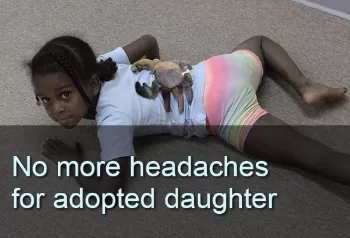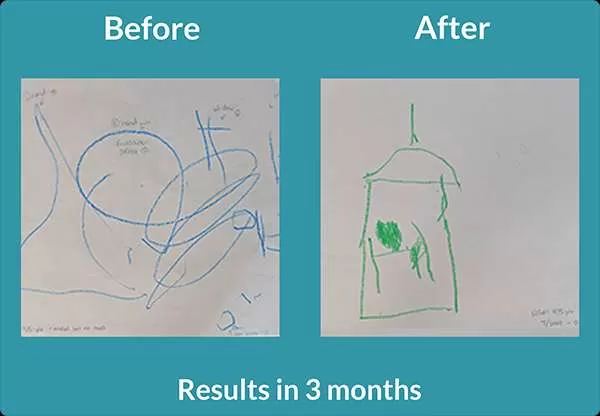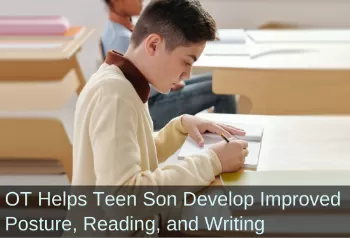Pain
Freedom from Pain with Rhythmic and Reflex Movements
by Sonia Story, M.S.
Do we have a duty to ourselves and our children to be as free as possible from physical and emotional pain? Do you see ways that your child is in pain? Do you have pain?
Anxiety, shyness, aches, tension, fatigue, hypersensitivities, headaches, frustration, and lack of confidence can all be physically or emotionally painful. These physical and emotional pains may be coming from the same source—a compromised neuro-sensory-motor system (NSM system). When the NSM system is underdeveloped, it can leave us unable to focus, and stuck in fight-or-flight—an uncomfortable state of irritability, and hyper-vigilance.
An underdeveloped NSM system can also cause tension, tightness, weak muscles, upset, hyper-sensitivities, or an inability to communicate and connect with others—any of these can lead to physical and emotional pain.
Could it be that, when children are combative, the underlying cause is really pain?
Pain can be a blessing when it is a wake-up call to do something different. Pain is a signal to guide us to where help is needed. And it can be life-changing when we take action and find new ways of being.
Whether it is physical or emotional pain, by doing specific, targeted movements from the Brain and Sensory Foundations course, the NSM system becomes calmer and more mature. Directly transforming the nervous system makes all the difference. There are simple rhythmic movements and help for retained primitive reflexes that can lift pain and increase joy for you and those you care for.
How can Rhythmic Movements and Reflex Integration Work for Both Physical and Emotional Pain?
The answer lies in the intersection between the brain, nerves, and sensory-motor systems.
I have personally seen the tools taught in the Brain and Sensory Foundations First Level course appear to work wonders to turn around pain for children and adults. We have hundreds of case studies from our students that confirm and support the far-reaching transformations these tools bring.
Here is an example:
"I have had plantar fasciitis for a few years now on my right foot only. It would come and go and I was treating it with standard stretching of my calf muscle, massaging and stretching my plantar tendon. Both of these would help to a certain extent but this last time it returned, those efforts did not seem to help. I was re-doing level 1 [of the Brain and Sensory Foundation course] and decided to try the plantar integration techniques. It was better after day 1 and the pain was entirely gone after day 3 of doing the isometric movements morning and night. Now I only do it once a day and sometimes I forget and it still has not returned. Nice!!" Rosanne Papadopoulos, Occupational Therapist
Another occupational therapist, wrote this about her work wth the Hand reflex integration from the Brain and Sensory Foundations course:
"In everyday life I intermittently have pain in my thumb joint requiring me to wear a splint and since doing this reflex I have not had any of this type of pain or had to wear the splint." S.P.
While we cannot promise a certain result for any given individual or condition, we can try these neurodevelopmental movements and see if they are helpful. I have heard so many success stories over the years that I always say, “It is worth a try!” Check out this mother's amazing story about pain relief using primitive reflex integration.
- There is the child who suffered trauma and neglect, who can now
connect with his adoptive parents - There is the young law student who is finding freedom from her
intense anxiety and ADHD symptoms - A young woman with social anxiety can now speak easily and
make friends for the first time - And so many children have found calm and relief from painful
sensory issues
Here are more examples to enjoy:
This mom was concerned about her daughter's developmental delay, neck pain and headaches, moodiness, and potty training. Read the full case study to see how neurodevelopmental movements quickly helped resolve her headaches and neck pain, as well as address several other issues.
Daily headaches after preschool had this 4-year-old's mother worried. After using tools from the Brain and Sensory Foundations course, his mother helped him resolve his headaches. The full case study describes how these tools also addressed his social-emotional regulation, sleep issues, anxiety, and fine-motor skills.
After two weeks of rhythmic movements and primitive reflex integration, this mom saw improvements in her son's posture. Find out how, after a month of neurodevelopmental movements, his writing was more legible, his reading had improved, and he was no longer experiencing hand pain when writing.
Disruptive behavior, anxiety, and an inability to pay attention—suspected as a result of physical trauma—made it difficult for this little boy to navigate a classroom environment. Read how after three months of rhythmic movements and primitive reflex integration, he is a much calmer and happier child, and able to enjoy school.
With neurodevelopmental movements, you may be able to do more than you ever thought possible to help children and adults with pain and other challenges. If you are not already enrolled, now is the time to benefit from the unique tools in the Brain and Sensory Foundations course.
A Pain in the Neck, How Reflex Integration Can Help
by Sonia Story, M.S.
When I first experienced the enlivening benefits of rhythmic movements and primitive reflex integration, I was on a wonderful journey of exploration—it felt so good to be more calm, less anxious, less hypersensitive, more spontaneously joyful, and more focused. I had done these neurodevelopmental movements for 4 months, nearly every day, and I had never before experienced such freedom and ability in my mental, emotional, and physical functioning. I felt GREAT!
Until…A severe injury left me bedridden.
I was unable to walk normally. I could not sit without pain. If I stood for more than 5 minutes, I became exhausted and my entire back burned with debilitating pain. After weeks of forced rest with little improvement, I was mightily discouraged. I was lying in bed one-day re-reading information about the Tonic Labyrinthine Reflex (TLR). It dawned on me that because of the injury, my TLR probably needed some help. TLR had never been an issue for me previously. With caution and a lot of stiffness, I got out of bed to check my TLR—sure enough, it had become severely unintegrated with the injury! So I did the movements to help the TLR and to my astonishment, my pain subsided by approximately 50% that day.
Every day I continued to integrate my TLR along with other primitive and postural reflexes. Little by little, my pain diminished and that started me on the path of developing much greater mobility and function. I eventually also sought out other bodywork modalities. However, it was the reflex work that provided the initial pain reduction that was so helpful for me to begin to relax and heal. Both Harald Blomberg, MD and Svetlana Masgutova taught that it is important to check and integrate primitive reflexes after an injury to help ease pain and speed recovery. I now had my own intimate experience of the truth of the principle.
Nearly two decades later, I am getting the message again that reflex integration can be an important key to dealing with pain. I recently had an unexplained pain in the neck and limited range of motion for more than 2 months despite multiple chiropractic and acupuncture treatments—which partially helped, but most of the pain and stiffness remained. One day the pain radiated from my neck and down my right shoulder, arm, and wrist. I worked on integrating my Asymmetrical Tonic Neck Reflex (ATNR) and my Moro reflex, which helped with the shoulder, arm, and wrist pain, but the pain in the neck persisted. Later I figured out that I also needed to work on the Headrighting Reflexes and that made the biggest difference for me. After the first round of doing Headrighting isometric activities from the Brain and Sensory Foundations, First Level training, I got a noticeable 50% reduction in the neck pain and better range of motion. I am so grateful for these tools!
5 possible reasons that unintegrated primitive reflexes and underdeveloped postural reflexes may be at the root of pain, and why integrating and maturing these reflexes can help to resolve pain.
The following challenges—all of which could develop into persistent pain—are associated with infant reflexes that are unintegrated or underdeveloped.
Without fully mature infant reflexes:
- The nervous system is underdeveloped, often in reactive fight or flight states, resulting in anxiety. Pain is known to be more acute, and harder to manage, when anxiety is also present.
- There is often poor alignment, poor posture, weak core strength, fatigue, and poor balance. These challenges force the body to compensate with movements that are inefficient and imbalanced.
- Muscles are underdeveloped leading to muscle weakness, muscle tension, and muscle imbalances.
- Tension headaches are common.
- The sensory systems are underdeveloped, leading to hypersensitivities and stress that make it more likely to experience pain.
Therapists report excellent progress in pain relief for their clients using neurodevelopmental movements
"I have been a PT for over 20 years and have specialized training in many modalities. Working with rhythmic movements and reflex integration has revolutionized my practice. I have seen wonderful results with my adult orthopedic clients.
I love sharing the rhythmic movements with clients because they are easy to do, fun, and relaxing. Clients report much less pain after doing the movements regularly at home, or doing them immediately when pain begins either to stop it and/or to not let the pain get worse. It has been especially helpful for clients with back pain, sciatica, plantar fasciitis, neck pain, and shoulder and postural issues. With the rhythmic movement there is less recurrence of pain, much more movement integration and ease of movement, more relaxation in the entire body, and clients report feeling happier as well." Marion Klein, PT"I work with clients who are in pain or who have limited mobility. The results I see using the rhythmic movement and reflex integration tools from the Brain and Sensory Foundations courses have been beyond amazing."
Sue Kruszewski, Therapeutic Yoga, Edmonton, Alberta, Canada
The experiences of these therapists point to the unique and special benefits of neurodevelopmental movements for reducing pain and boosting function. See also how these special movements promote better posture, core strength, and stamina.
Sonia Story, M.S. has been teaching neurodevelopmental movements since 2006.
Sonia developed the Brain and Sensory Foundations program to provide comprehensive training in neurodevelopmental movements—combining innate rhythmic movements, play, primitive reflexes, and postural reflexes.
She earned a Bachelor's degree in biology/psychology and a Master’s degree in Movement Sciences. She is the author of The Importance of Reflex Integration and the Evidence eBook, giving the rationale and evidence basis for using neurodevelopmental movements for helping with challenges such as ADHD, Sensory Processing Disorders, anxiety, emotional dysregulation, visual skill deficits, poor social skills, gross and fine motor delays and other neurodevelopmental and behavioral disorders.
Her work is featured in numerous podcasts, summits, and conferences, and in the books Almost Autism: Recovering Children from Sensory Processing Disorder; Special Ed Mom Survival Guide; Family Health Revolution; and Same Journey, Different Paths—Stories of Auditory Processing Disorder.
Sonia’s mission is to help children and families experience the profound benefits of neurodevelopmental and integrative movements for more functional and fulfilling lives.






